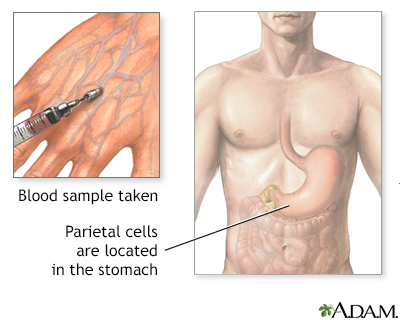Pregnancy SmartSiteTM
APCA; Anti-gastric parietal cell antibody; Atrophic gastritis - anti-gastric parietal cell antibody; Gastric ulcer - anti-gastric parietal cell antibody; Pernicious anemia - anti-gastric parietal cell antibody; Vitamin B12 - anti-gastric parietal cell antibody DefinitionAn antiparietal cell antibody test is a blood test that looks for antibodies against the parietal cells of the stomach. The parietal cells make and release a substance called intrinsic factor that the body needs to absorb vitamin B12. How the Test is PerformedA blood sample is needed. How to Prepare for the TestNo special preparation is necessary. How the Test will FeelWhen the needle is inserted to draw blood, some people feel moderate pain. Others feel only a prick or stinging. Afterward, there may be some throbbing or slight bruising. This soon goes away. Why the Test is PerformedYour health care provider may use this test to help diagnose pernicious anemia. Pernicious anemia is a decrease in red blood cells that occurs when your intestines cannot properly absorb vitamin B12. Other tests are also used to help with the diagnosis. Normal ResultsA normal result is called a negative result. Normal value ranges may vary slightly among different laboratories. Some labs use different measurements or test different samples. Talk to your provider about the meaning of your specific test results. What Abnormal Results MeanAn abnormal result is called a positive result. This may be due to:
RisksThere is little risk involved with having your blood taken. Veins and arteries vary in size from one person to another, and from one side of the body to the other. Taking blood from some people may be more difficult than from others. Other risks associated with having blood drawn are slight, but may include:
ReferencesCooling LL, Downs T. Immunohematology. In: McPherson RA, Pincus MR, eds. Henry's Clinical Diagnosis and Management by Laboratory Methods. 24th ed. Philadelphia, PA: Elsevier; 2022:chap 36. Höegenauer C, Hammer HF. Maldigestion and malabsorption. In: Feldman M, Friedman LS, Brandt LJ, eds. Sleisenger and Fordtran's Gastrointestinal and Liver Disease. 11th ed. Philadelphia, PA: Elsevier; 2021:chap 104. Marcogliese AN, Hensch L. Resources for the hematologist: interpretive comments and selected reference values for neonatal, pediatric, and adult populations. In: Hoffman R, Benz EJ, Silberstein LE, et al, eds. Hematology: Basic Principles and Practice. 8th ed. Philadelphia, PA: Elsevier; 2023:chap 159. Stabler SP. Megaloblastic anemias. In: Goldman L, Cooney KA, eds. Goldman-Cecil Medicine. 27th ed. Philadelphia, PA: Elsevier; 2024:chap 150. | |
| |
Review Date: 3/31/2024 Reviewed By: Todd Gersten, MD, Hematology/Oncology, Florida Cancer Specialists & Research Institute, Wellington, FL. Review provided by VeriMed Healthcare Network. Also reviewed by David C. Dugdale, MD, Medical Director, Brenda Conaway, Editorial Director, and the A.D.A.M. Editorial team. The information provided herein should not be used during any medical emergency or for the diagnosis or treatment of any medical condition. A licensed medical professional should be consulted for diagnosis and treatment of any and all medical conditions. Links to other sites are provided for information only -- they do not constitute endorsements of those other sites. No warranty of any kind, either expressed or implied, is made as to the accuracy, reliability, timeliness, or correctness of any translations made by a third-party service of the information provided herein into any other language. © 1997- A.D.A.M., a business unit of Ebix, Inc. Any duplication or distribution of the information contained herein is strictly prohibited. | |

 Antiparietal cell ...
Antiparietal cell ...
